Managerial Economics Analysis: AT&T Acquisition and Apple Strategies
VerifiedAdded on 2020/06/06
|13
|3995
|77
Report
AI Summary
This report delves into the realm of managerial economics, examining two key aspects: the AT&T acquisition of BellSouth and the strategic maneuvers of Apple. The first section scrutinizes the motives behind mergers and acquisitions, specifically focusing on the AT&T-BellSouth deal, analyzing its rationale, economic factors like economies of scale and demand elasticity, and the impact on market dynamics through Porter's Five Forces model. The second part of the report pivots to Apple, dissecting its pricing and non-pricing strategies, its tactics to counter market entry threats, and its ability to maintain a dominant position. The report covers the role of demand and supply, and the factors that contribute to the success of the company. The analysis considers economic concepts and provides a comprehensive understanding of how these companies navigate the competitive landscape.
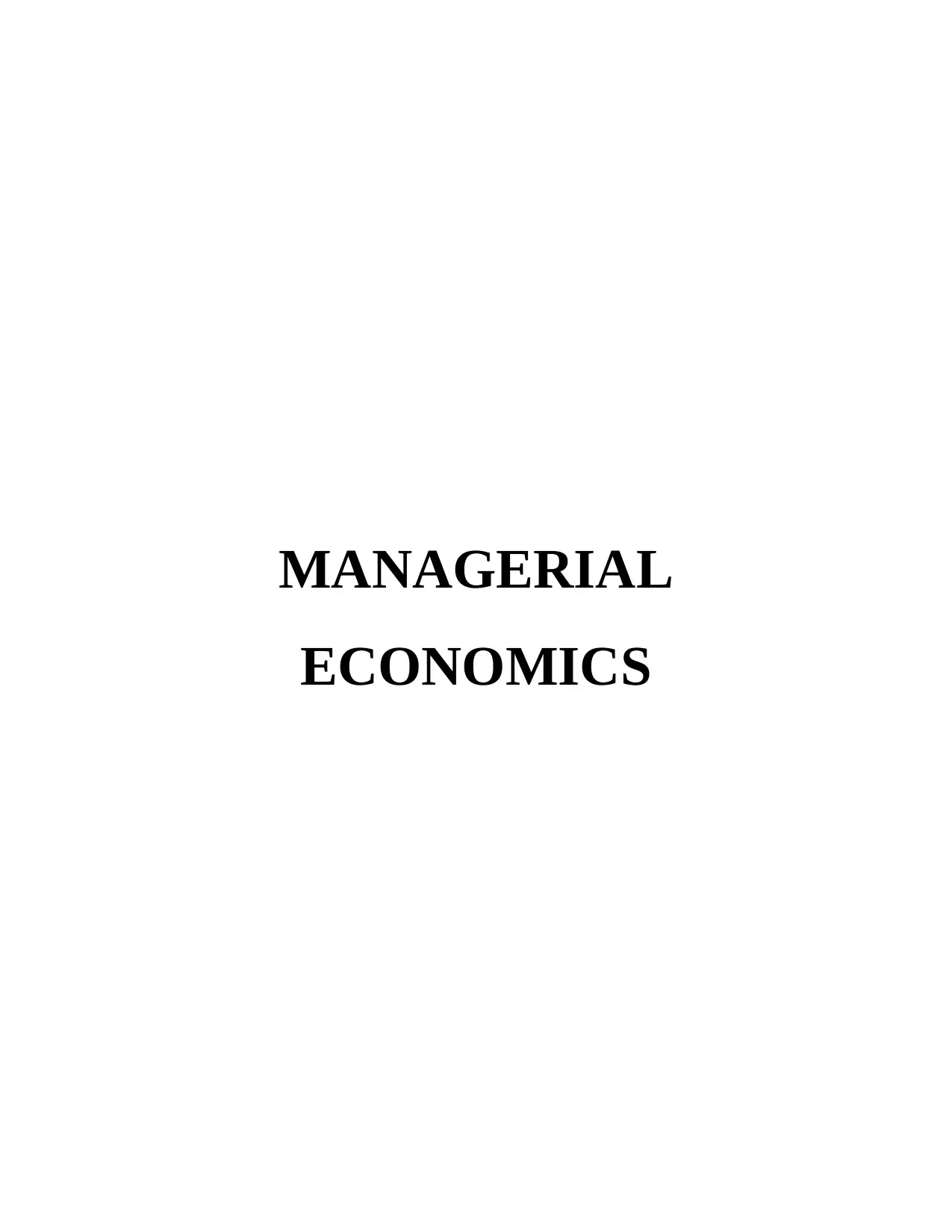
MANAGERIAL
ECONOMICS
ECONOMICS
Paraphrase This Document
Need a fresh take? Get an instant paraphrase of this document with our AI Paraphraser
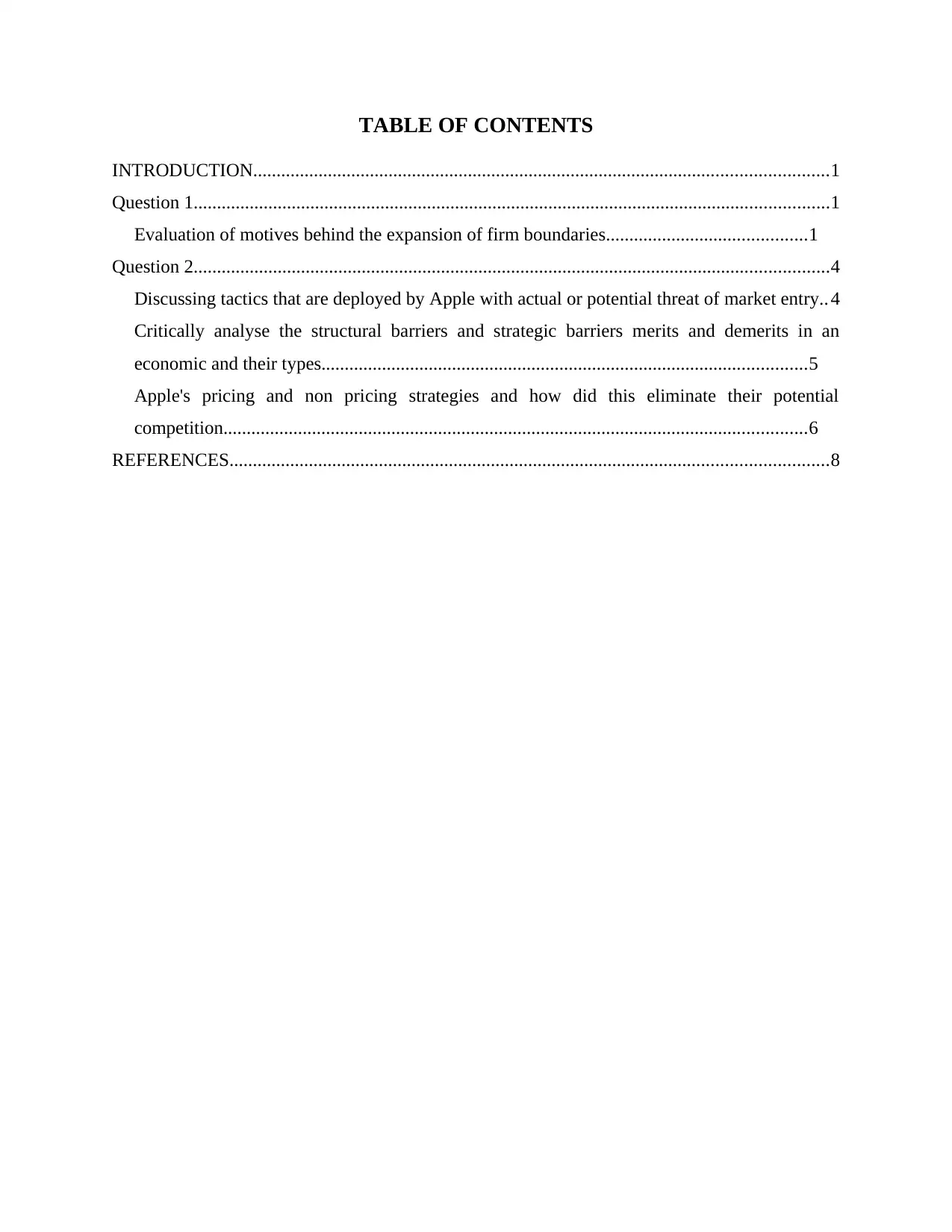
TABLE OF CONTENTS
INTRODUCTION...........................................................................................................................1
Question 1........................................................................................................................................1
Evaluation of motives behind the expansion of firm boundaries...........................................1
Question 2........................................................................................................................................4
Discussing tactics that are deployed by Apple with actual or potential threat of market entry.. 4
Critically analyse the structural barriers and strategic barriers merits and demerits in an
economic and their types........................................................................................................5
Apple's pricing and non pricing strategies and how did this eliminate their potential
competition.............................................................................................................................6
REFERENCES................................................................................................................................8
INTRODUCTION...........................................................................................................................1
Question 1........................................................................................................................................1
Evaluation of motives behind the expansion of firm boundaries...........................................1
Question 2........................................................................................................................................4
Discussing tactics that are deployed by Apple with actual or potential threat of market entry.. 4
Critically analyse the structural barriers and strategic barriers merits and demerits in an
economic and their types........................................................................................................5
Apple's pricing and non pricing strategies and how did this eliminate their potential
competition.............................................................................................................................6
REFERENCES................................................................................................................................8
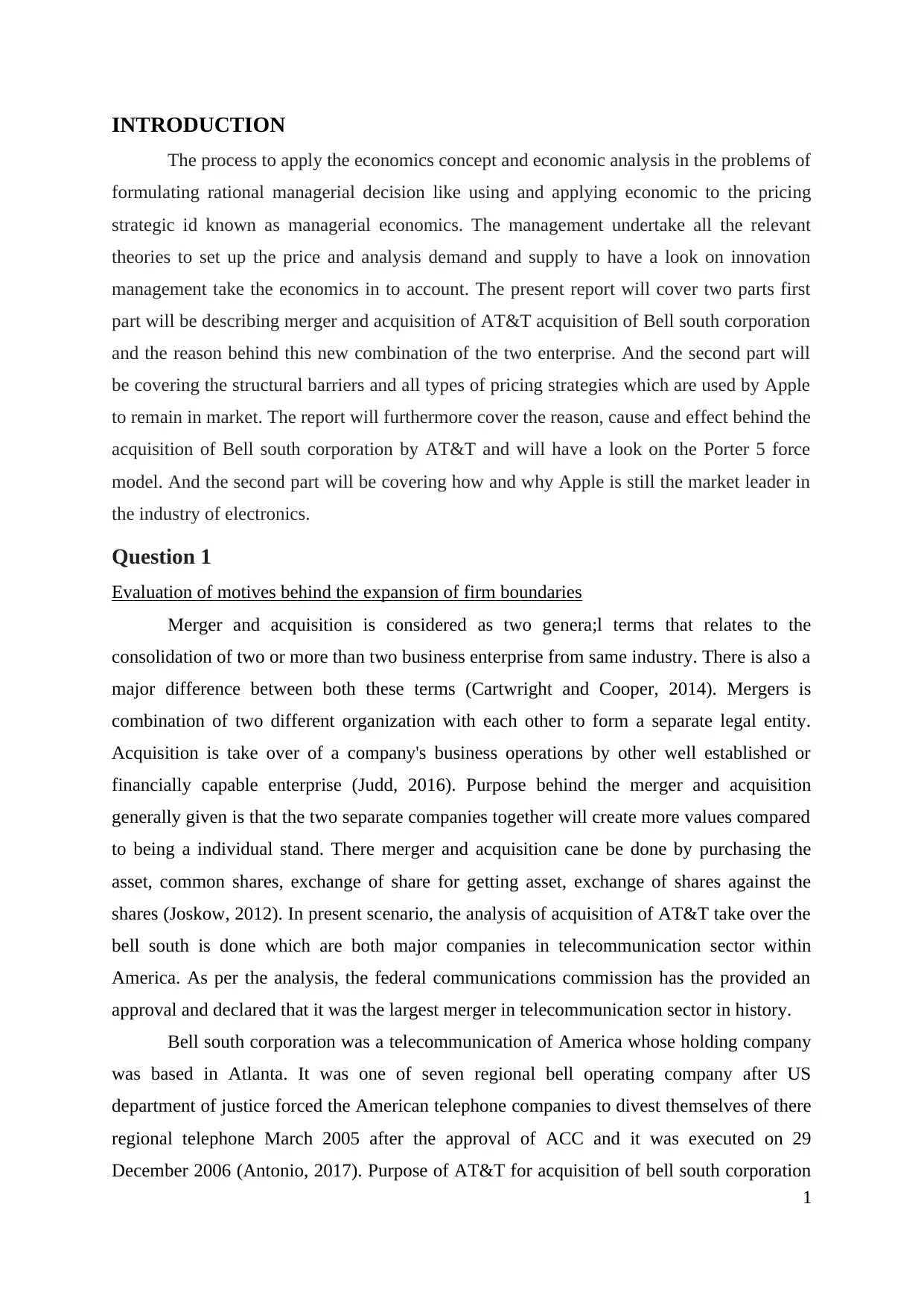
INTRODUCTION
The process to apply the economics concept and economic analysis in the problems of
formulating rational managerial decision like using and applying economic to the pricing
strategic id known as managerial economics. The management undertake all the relevant
theories to set up the price and analysis demand and supply to have a look on innovation
management take the economics in to account. The present report will cover two parts first
part will be describing merger and acquisition of AT&T acquisition of Bell south corporation
and the reason behind this new combination of the two enterprise. And the second part will
be covering the structural barriers and all types of pricing strategies which are used by Apple
to remain in market. The report will furthermore cover the reason, cause and effect behind the
acquisition of Bell south corporation by AT&T and will have a look on the Porter 5 force
model. And the second part will be covering how and why Apple is still the market leader in
the industry of electronics.
Question 1
Evaluation of motives behind the expansion of firm boundaries
Merger and acquisition is considered as two genera;l terms that relates to the
consolidation of two or more than two business enterprise from same industry. There is also a
major difference between both these terms (Cartwright and Cooper, 2014). Mergers is
combination of two different organization with each other to form a separate legal entity.
Acquisition is take over of a company's business operations by other well established or
financially capable enterprise (Judd, 2016). Purpose behind the merger and acquisition
generally given is that the two separate companies together will create more values compared
to being a individual stand. There merger and acquisition cane be done by purchasing the
asset, common shares, exchange of share for getting asset, exchange of shares against the
shares (Joskow, 2012). In present scenario, the analysis of acquisition of AT&T take over the
bell south is done which are both major companies in telecommunication sector within
America. As per the analysis, the federal communications commission has the provided an
approval and declared that it was the largest merger in telecommunication sector in history.
Bell south corporation was a telecommunication of America whose holding company
was based in Atlanta. It was one of seven regional bell operating company after US
department of justice forced the American telephone companies to divest themselves of there
regional telephone March 2005 after the approval of ACC and it was executed on 29
December 2006 (Antonio, 2017). Purpose of AT&T for acquisition of bell south corporation
1
The process to apply the economics concept and economic analysis in the problems of
formulating rational managerial decision like using and applying economic to the pricing
strategic id known as managerial economics. The management undertake all the relevant
theories to set up the price and analysis demand and supply to have a look on innovation
management take the economics in to account. The present report will cover two parts first
part will be describing merger and acquisition of AT&T acquisition of Bell south corporation
and the reason behind this new combination of the two enterprise. And the second part will
be covering the structural barriers and all types of pricing strategies which are used by Apple
to remain in market. The report will furthermore cover the reason, cause and effect behind the
acquisition of Bell south corporation by AT&T and will have a look on the Porter 5 force
model. And the second part will be covering how and why Apple is still the market leader in
the industry of electronics.
Question 1
Evaluation of motives behind the expansion of firm boundaries
Merger and acquisition is considered as two genera;l terms that relates to the
consolidation of two or more than two business enterprise from same industry. There is also a
major difference between both these terms (Cartwright and Cooper, 2014). Mergers is
combination of two different organization with each other to form a separate legal entity.
Acquisition is take over of a company's business operations by other well established or
financially capable enterprise (Judd, 2016). Purpose behind the merger and acquisition
generally given is that the two separate companies together will create more values compared
to being a individual stand. There merger and acquisition cane be done by purchasing the
asset, common shares, exchange of share for getting asset, exchange of shares against the
shares (Joskow, 2012). In present scenario, the analysis of acquisition of AT&T take over the
bell south is done which are both major companies in telecommunication sector within
America. As per the analysis, the federal communications commission has the provided an
approval and declared that it was the largest merger in telecommunication sector in history.
Bell south corporation was a telecommunication of America whose holding company
was based in Atlanta. It was one of seven regional bell operating company after US
department of justice forced the American telephone companies to divest themselves of there
regional telephone March 2005 after the approval of ACC and it was executed on 29
December 2006 (Antonio, 2017). Purpose of AT&T for acquisition of bell south corporation
1
⊘ This is a preview!⊘
Do you want full access?
Subscribe today to unlock all pages.

Trusted by 1+ million students worldwide
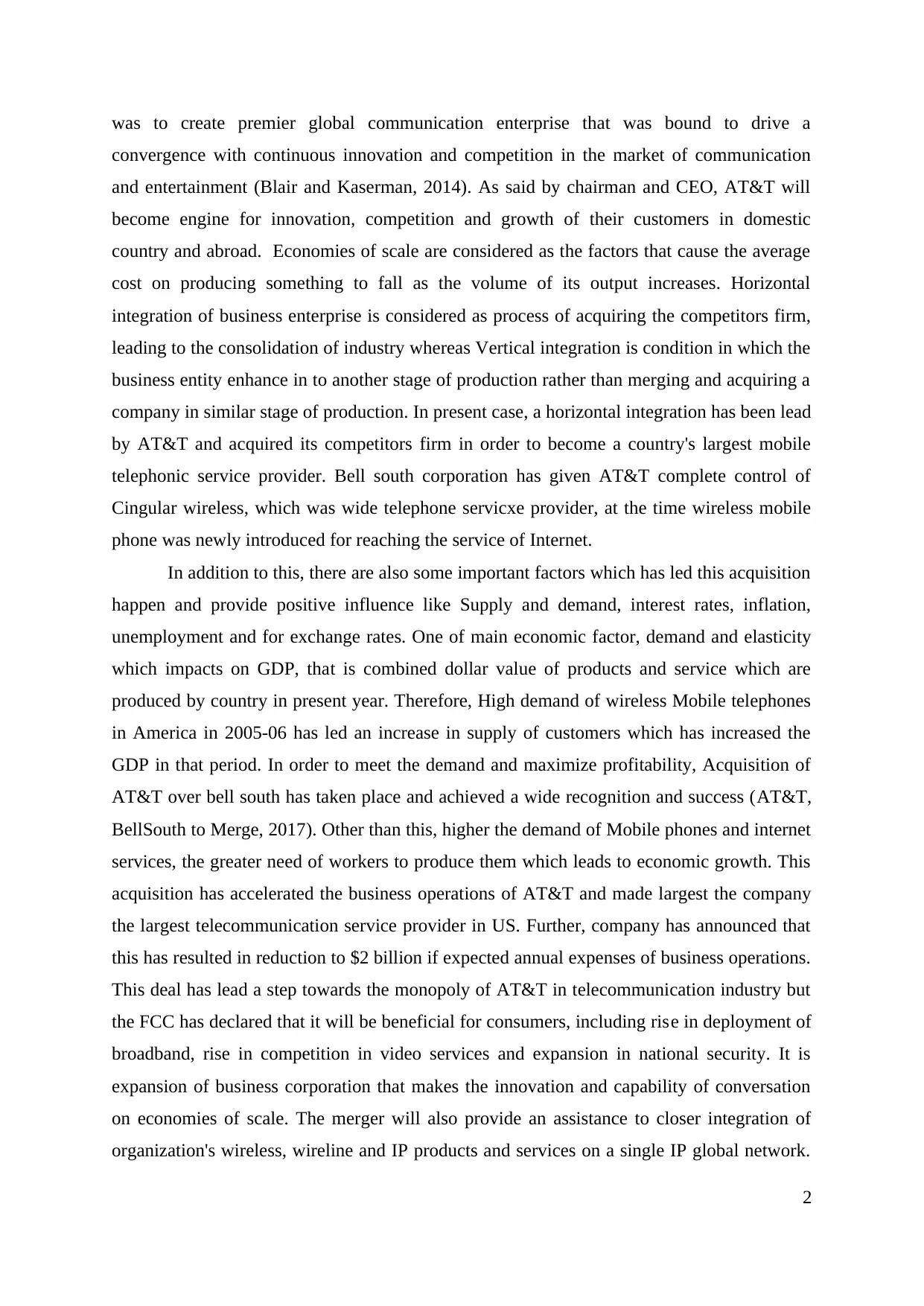
was to create premier global communication enterprise that was bound to drive a
convergence with continuous innovation and competition in the market of communication
and entertainment (Blair and Kaserman, 2014). As said by chairman and CEO, AT&T will
become engine for innovation, competition and growth of their customers in domestic
country and abroad. Economies of scale are considered as the factors that cause the average
cost on producing something to fall as the volume of its output increases. Horizontal
integration of business enterprise is considered as process of acquiring the competitors firm,
leading to the consolidation of industry whereas Vertical integration is condition in which the
business entity enhance in to another stage of production rather than merging and acquiring a
company in similar stage of production. In present case, a horizontal integration has been lead
by AT&T and acquired its competitors firm in order to become a country's largest mobile
telephonic service provider. Bell south corporation has given AT&T complete control of
Cingular wireless, which was wide telephone servicxe provider, at the time wireless mobile
phone was newly introduced for reaching the service of Internet.
In addition to this, there are also some important factors which has led this acquisition
happen and provide positive influence like Supply and demand, interest rates, inflation,
unemployment and for exchange rates. One of main economic factor, demand and elasticity
which impacts on GDP, that is combined dollar value of products and service which are
produced by country in present year. Therefore, High demand of wireless Mobile telephones
in America in 2005-06 has led an increase in supply of customers which has increased the
GDP in that period. In order to meet the demand and maximize profitability, Acquisition of
AT&T over bell south has taken place and achieved a wide recognition and success (AT&T,
BellSouth to Merge, 2017). Other than this, higher the demand of Mobile phones and internet
services, the greater need of workers to produce them which leads to economic growth. This
acquisition has accelerated the business operations of AT&T and made largest the company
the largest telecommunication service provider in US. Further, company has announced that
this has resulted in reduction to $2 billion if expected annual expenses of business operations.
This deal has lead a step towards the monopoly of AT&T in telecommunication industry but
the FCC has declared that it will be beneficial for consumers, including rise in deployment of
broadband, rise in competition in video services and expansion in national security. It is
expansion of business corporation that makes the innovation and capability of conversation
on economies of scale. The merger will also provide an assistance to closer integration of
organization's wireless, wireline and IP products and services on a single IP global network.
2
convergence with continuous innovation and competition in the market of communication
and entertainment (Blair and Kaserman, 2014). As said by chairman and CEO, AT&T will
become engine for innovation, competition and growth of their customers in domestic
country and abroad. Economies of scale are considered as the factors that cause the average
cost on producing something to fall as the volume of its output increases. Horizontal
integration of business enterprise is considered as process of acquiring the competitors firm,
leading to the consolidation of industry whereas Vertical integration is condition in which the
business entity enhance in to another stage of production rather than merging and acquiring a
company in similar stage of production. In present case, a horizontal integration has been lead
by AT&T and acquired its competitors firm in order to become a country's largest mobile
telephonic service provider. Bell south corporation has given AT&T complete control of
Cingular wireless, which was wide telephone servicxe provider, at the time wireless mobile
phone was newly introduced for reaching the service of Internet.
In addition to this, there are also some important factors which has led this acquisition
happen and provide positive influence like Supply and demand, interest rates, inflation,
unemployment and for exchange rates. One of main economic factor, demand and elasticity
which impacts on GDP, that is combined dollar value of products and service which are
produced by country in present year. Therefore, High demand of wireless Mobile telephones
in America in 2005-06 has led an increase in supply of customers which has increased the
GDP in that period. In order to meet the demand and maximize profitability, Acquisition of
AT&T over bell south has taken place and achieved a wide recognition and success (AT&T,
BellSouth to Merge, 2017). Other than this, higher the demand of Mobile phones and internet
services, the greater need of workers to produce them which leads to economic growth. This
acquisition has accelerated the business operations of AT&T and made largest the company
the largest telecommunication service provider in US. Further, company has announced that
this has resulted in reduction to $2 billion if expected annual expenses of business operations.
This deal has lead a step towards the monopoly of AT&T in telecommunication industry but
the FCC has declared that it will be beneficial for consumers, including rise in deployment of
broadband, rise in competition in video services and expansion in national security. It is
expansion of business corporation that makes the innovation and capability of conversation
on economies of scale. The merger will also provide an assistance to closer integration of
organization's wireless, wireline and IP products and services on a single IP global network.
2
Paraphrase This Document
Need a fresh take? Get an instant paraphrase of this document with our AI Paraphraser
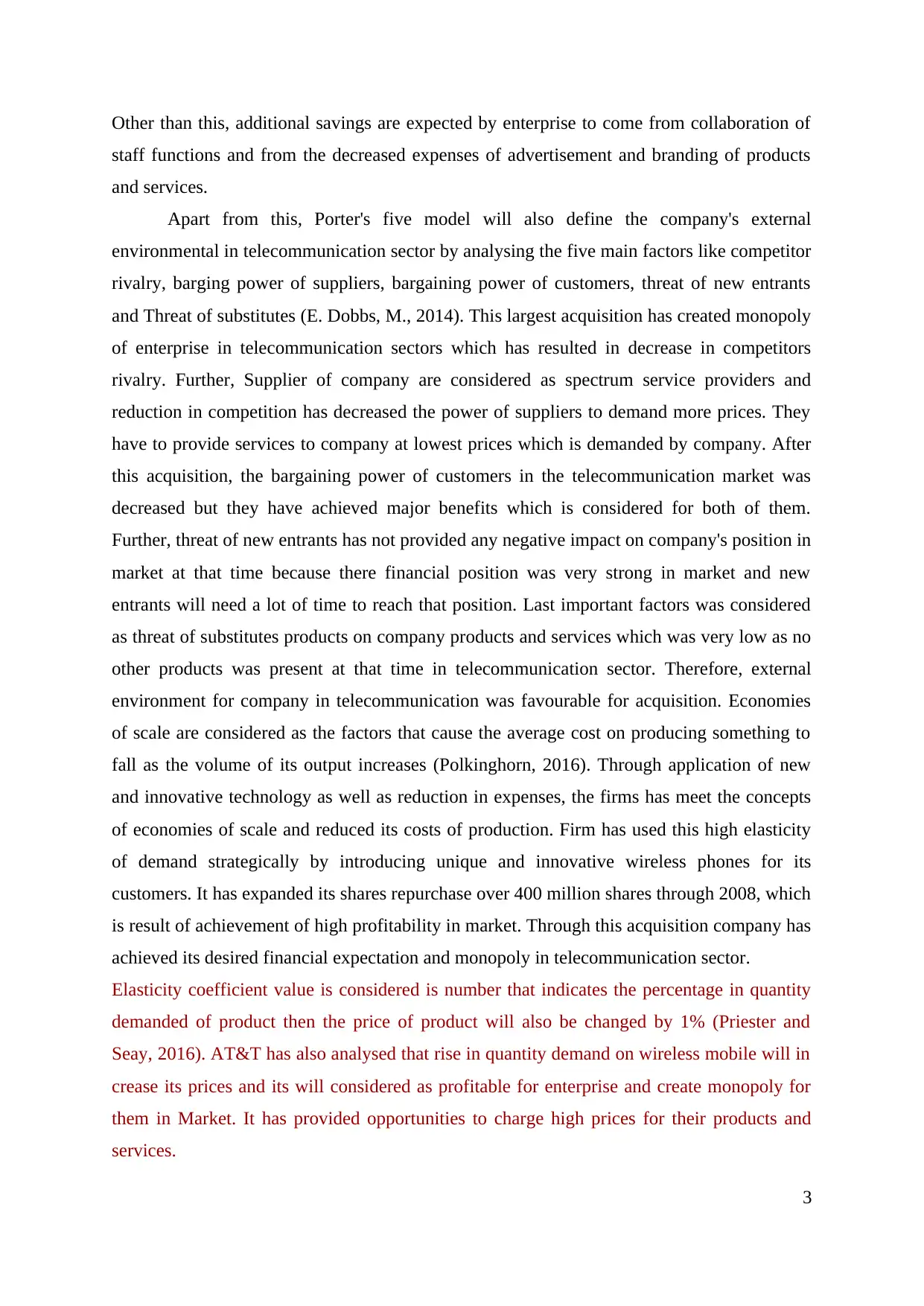
Other than this, additional savings are expected by enterprise to come from collaboration of
staff functions and from the decreased expenses of advertisement and branding of products
and services.
Apart from this, Porter's five model will also define the company's external
environmental in telecommunication sector by analysing the five main factors like competitor
rivalry, barging power of suppliers, bargaining power of customers, threat of new entrants
and Threat of substitutes (E. Dobbs, M., 2014). This largest acquisition has created monopoly
of enterprise in telecommunication sectors which has resulted in decrease in competitors
rivalry. Further, Supplier of company are considered as spectrum service providers and
reduction in competition has decreased the power of suppliers to demand more prices. They
have to provide services to company at lowest prices which is demanded by company. After
this acquisition, the bargaining power of customers in the telecommunication market was
decreased but they have achieved major benefits which is considered for both of them.
Further, threat of new entrants has not provided any negative impact on company's position in
market at that time because there financial position was very strong in market and new
entrants will need a lot of time to reach that position. Last important factors was considered
as threat of substitutes products on company products and services which was very low as no
other products was present at that time in telecommunication sector. Therefore, external
environment for company in telecommunication was favourable for acquisition. Economies
of scale are considered as the factors that cause the average cost on producing something to
fall as the volume of its output increases (Polkinghorn, 2016). Through application of new
and innovative technology as well as reduction in expenses, the firms has meet the concepts
of economies of scale and reduced its costs of production. Firm has used this high elasticity
of demand strategically by introducing unique and innovative wireless phones for its
customers. It has expanded its shares repurchase over 400 million shares through 2008, which
is result of achievement of high profitability in market. Through this acquisition company has
achieved its desired financial expectation and monopoly in telecommunication sector.
Elasticity coefficient value is considered is number that indicates the percentage in quantity
demanded of product then the price of product will also be changed by 1% (Priester and
Seay, 2016). AT&T has also analysed that rise in quantity demand on wireless mobile will in
crease its prices and its will considered as profitable for enterprise and create monopoly for
them in Market. It has provided opportunities to charge high prices for their products and
services.
3
staff functions and from the decreased expenses of advertisement and branding of products
and services.
Apart from this, Porter's five model will also define the company's external
environmental in telecommunication sector by analysing the five main factors like competitor
rivalry, barging power of suppliers, bargaining power of customers, threat of new entrants
and Threat of substitutes (E. Dobbs, M., 2014). This largest acquisition has created monopoly
of enterprise in telecommunication sectors which has resulted in decrease in competitors
rivalry. Further, Supplier of company are considered as spectrum service providers and
reduction in competition has decreased the power of suppliers to demand more prices. They
have to provide services to company at lowest prices which is demanded by company. After
this acquisition, the bargaining power of customers in the telecommunication market was
decreased but they have achieved major benefits which is considered for both of them.
Further, threat of new entrants has not provided any negative impact on company's position in
market at that time because there financial position was very strong in market and new
entrants will need a lot of time to reach that position. Last important factors was considered
as threat of substitutes products on company products and services which was very low as no
other products was present at that time in telecommunication sector. Therefore, external
environment for company in telecommunication was favourable for acquisition. Economies
of scale are considered as the factors that cause the average cost on producing something to
fall as the volume of its output increases (Polkinghorn, 2016). Through application of new
and innovative technology as well as reduction in expenses, the firms has meet the concepts
of economies of scale and reduced its costs of production. Firm has used this high elasticity
of demand strategically by introducing unique and innovative wireless phones for its
customers. It has expanded its shares repurchase over 400 million shares through 2008, which
is result of achievement of high profitability in market. Through this acquisition company has
achieved its desired financial expectation and monopoly in telecommunication sector.
Elasticity coefficient value is considered is number that indicates the percentage in quantity
demanded of product then the price of product will also be changed by 1% (Priester and
Seay, 2016). AT&T has also analysed that rise in quantity demand on wireless mobile will in
crease its prices and its will considered as profitable for enterprise and create monopoly for
them in Market. It has provided opportunities to charge high prices for their products and
services.
3
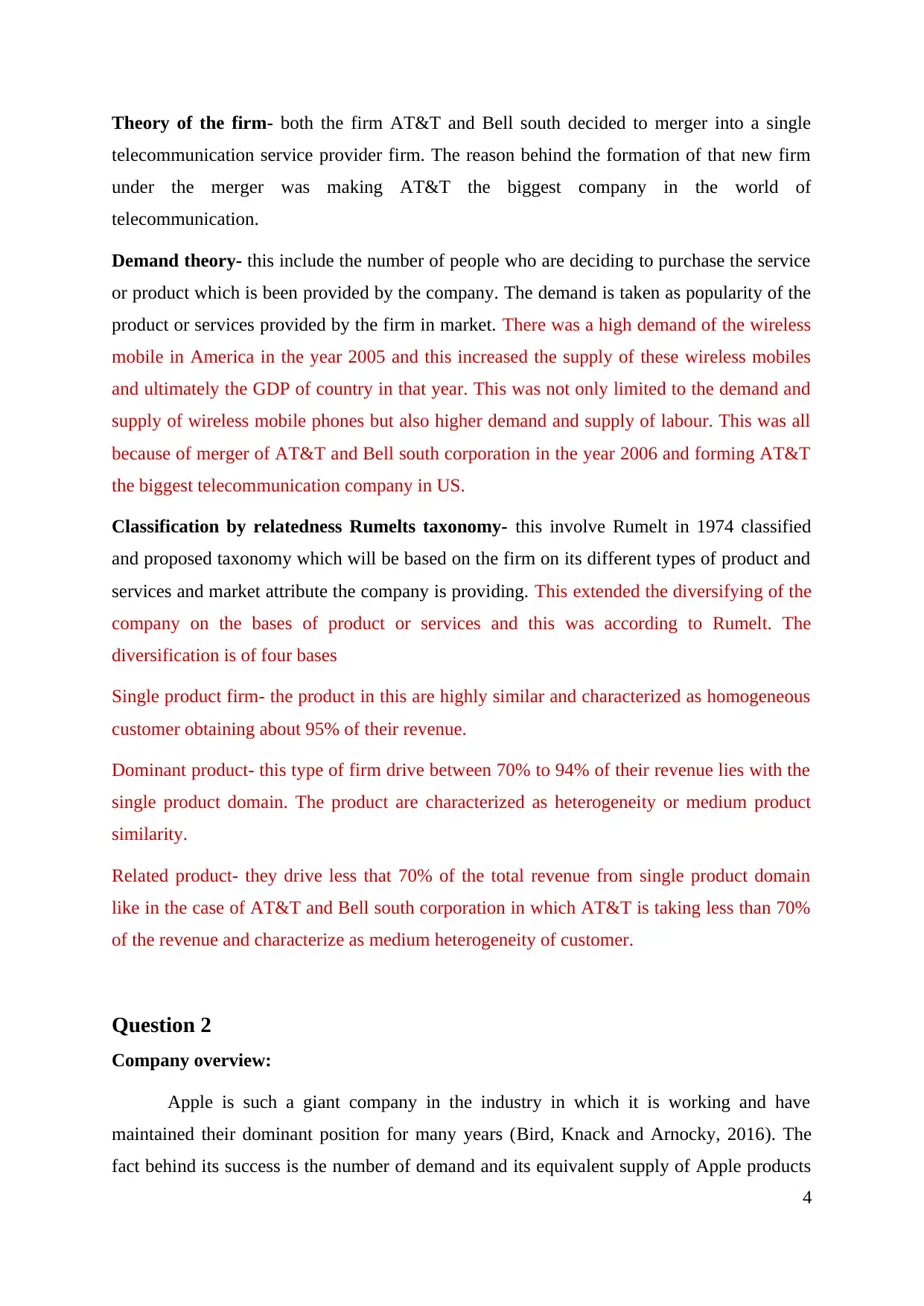
Theory of the firm- both the firm AT&T and Bell south decided to merger into a single
telecommunication service provider firm. The reason behind the formation of that new firm
under the merger was making AT&T the biggest company in the world of
telecommunication.
Demand theory- this include the number of people who are deciding to purchase the service
or product which is been provided by the company. The demand is taken as popularity of the
product or services provided by the firm in market. There was a high demand of the wireless
mobile in America in the year 2005 and this increased the supply of these wireless mobiles
and ultimately the GDP of country in that year. This was not only limited to the demand and
supply of wireless mobile phones but also higher demand and supply of labour. This was all
because of merger of AT&T and Bell south corporation in the year 2006 and forming AT&T
the biggest telecommunication company in US.
Classification by relatedness Rumelts taxonomy- this involve Rumelt in 1974 classified
and proposed taxonomy which will be based on the firm on its different types of product and
services and market attribute the company is providing. This extended the diversifying of the
company on the bases of product or services and this was according to Rumelt. The
diversification is of four bases
Single product firm- the product in this are highly similar and characterized as homogeneous
customer obtaining about 95% of their revenue.
Dominant product- this type of firm drive between 70% to 94% of their revenue lies with the
single product domain. The product are characterized as heterogeneity or medium product
similarity.
Related product- they drive less that 70% of the total revenue from single product domain
like in the case of AT&T and Bell south corporation in which AT&T is taking less than 70%
of the revenue and characterize as medium heterogeneity of customer.
Question 2
Company overview:
Apple is such a giant company in the industry in which it is working and have
maintained their dominant position for many years (Bird, Knack and Arnocky, 2016). The
fact behind its success is the number of demand and its equivalent supply of Apple products
4
telecommunication service provider firm. The reason behind the formation of that new firm
under the merger was making AT&T the biggest company in the world of
telecommunication.
Demand theory- this include the number of people who are deciding to purchase the service
or product which is been provided by the company. The demand is taken as popularity of the
product or services provided by the firm in market. There was a high demand of the wireless
mobile in America in the year 2005 and this increased the supply of these wireless mobiles
and ultimately the GDP of country in that year. This was not only limited to the demand and
supply of wireless mobile phones but also higher demand and supply of labour. This was all
because of merger of AT&T and Bell south corporation in the year 2006 and forming AT&T
the biggest telecommunication company in US.
Classification by relatedness Rumelts taxonomy- this involve Rumelt in 1974 classified
and proposed taxonomy which will be based on the firm on its different types of product and
services and market attribute the company is providing. This extended the diversifying of the
company on the bases of product or services and this was according to Rumelt. The
diversification is of four bases
Single product firm- the product in this are highly similar and characterized as homogeneous
customer obtaining about 95% of their revenue.
Dominant product- this type of firm drive between 70% to 94% of their revenue lies with the
single product domain. The product are characterized as heterogeneity or medium product
similarity.
Related product- they drive less that 70% of the total revenue from single product domain
like in the case of AT&T and Bell south corporation in which AT&T is taking less than 70%
of the revenue and characterize as medium heterogeneity of customer.
Question 2
Company overview:
Apple is such a giant company in the industry in which it is working and have
maintained their dominant position for many years (Bird, Knack and Arnocky, 2016). The
fact behind its success is the number of demand and its equivalent supply of Apple products
4
⊘ This is a preview!⊘
Do you want full access?
Subscribe today to unlock all pages.

Trusted by 1+ million students worldwide
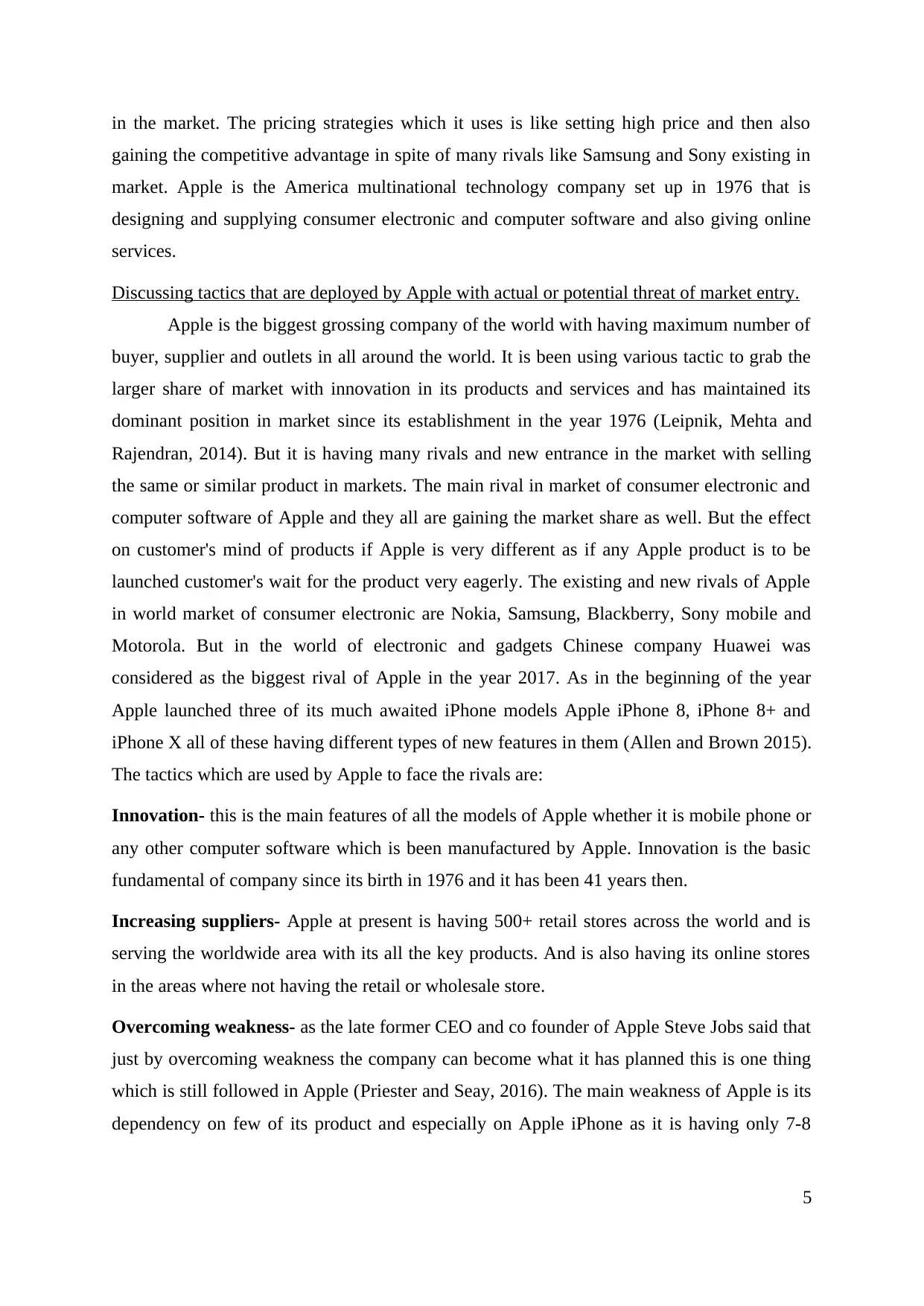
in the market. The pricing strategies which it uses is like setting high price and then also
gaining the competitive advantage in spite of many rivals like Samsung and Sony existing in
market. Apple is the America multinational technology company set up in 1976 that is
designing and supplying consumer electronic and computer software and also giving online
services.
Discussing tactics that are deployed by Apple with actual or potential threat of market entry.
Apple is the biggest grossing company of the world with having maximum number of
buyer, supplier and outlets in all around the world. It is been using various tactic to grab the
larger share of market with innovation in its products and services and has maintained its
dominant position in market since its establishment in the year 1976 (Leipnik, Mehta and
Rajendran, 2014). But it is having many rivals and new entrance in the market with selling
the same or similar product in markets. The main rival in market of consumer electronic and
computer software of Apple and they all are gaining the market share as well. But the effect
on customer's mind of products if Apple is very different as if any Apple product is to be
launched customer's wait for the product very eagerly. The existing and new rivals of Apple
in world market of consumer electronic are Nokia, Samsung, Blackberry, Sony mobile and
Motorola. But in the world of electronic and gadgets Chinese company Huawei was
considered as the biggest rival of Apple in the year 2017. As in the beginning of the year
Apple launched three of its much awaited iPhone models Apple iPhone 8, iPhone 8+ and
iPhone X all of these having different types of new features in them (Allen and Brown 2015).
The tactics which are used by Apple to face the rivals are:
Innovation- this is the main features of all the models of Apple whether it is mobile phone or
any other computer software which is been manufactured by Apple. Innovation is the basic
fundamental of company since its birth in 1976 and it has been 41 years then.
Increasing suppliers- Apple at present is having 500+ retail stores across the world and is
serving the worldwide area with its all the key products. And is also having its online stores
in the areas where not having the retail or wholesale store.
Overcoming weakness- as the late former CEO and co founder of Apple Steve Jobs said that
just by overcoming weakness the company can become what it has planned this is one thing
which is still followed in Apple (Priester and Seay, 2016). The main weakness of Apple is its
dependency on few of its product and especially on Apple iPhone as it is having only 7-8
5
gaining the competitive advantage in spite of many rivals like Samsung and Sony existing in
market. Apple is the America multinational technology company set up in 1976 that is
designing and supplying consumer electronic and computer software and also giving online
services.
Discussing tactics that are deployed by Apple with actual or potential threat of market entry.
Apple is the biggest grossing company of the world with having maximum number of
buyer, supplier and outlets in all around the world. It is been using various tactic to grab the
larger share of market with innovation in its products and services and has maintained its
dominant position in market since its establishment in the year 1976 (Leipnik, Mehta and
Rajendran, 2014). But it is having many rivals and new entrance in the market with selling
the same or similar product in markets. The main rival in market of consumer electronic and
computer software of Apple and they all are gaining the market share as well. But the effect
on customer's mind of products if Apple is very different as if any Apple product is to be
launched customer's wait for the product very eagerly. The existing and new rivals of Apple
in world market of consumer electronic are Nokia, Samsung, Blackberry, Sony mobile and
Motorola. But in the world of electronic and gadgets Chinese company Huawei was
considered as the biggest rival of Apple in the year 2017. As in the beginning of the year
Apple launched three of its much awaited iPhone models Apple iPhone 8, iPhone 8+ and
iPhone X all of these having different types of new features in them (Allen and Brown 2015).
The tactics which are used by Apple to face the rivals are:
Innovation- this is the main features of all the models of Apple whether it is mobile phone or
any other computer software which is been manufactured by Apple. Innovation is the basic
fundamental of company since its birth in 1976 and it has been 41 years then.
Increasing suppliers- Apple at present is having 500+ retail stores across the world and is
serving the worldwide area with its all the key products. And is also having its online stores
in the areas where not having the retail or wholesale store.
Overcoming weakness- as the late former CEO and co founder of Apple Steve Jobs said that
just by overcoming weakness the company can become what it has planned this is one thing
which is still followed in Apple (Priester and Seay, 2016). The main weakness of Apple is its
dependency on few of its product and especially on Apple iPhone as it is having only 7-8
5
Paraphrase This Document
Need a fresh take? Get an instant paraphrase of this document with our AI Paraphraser
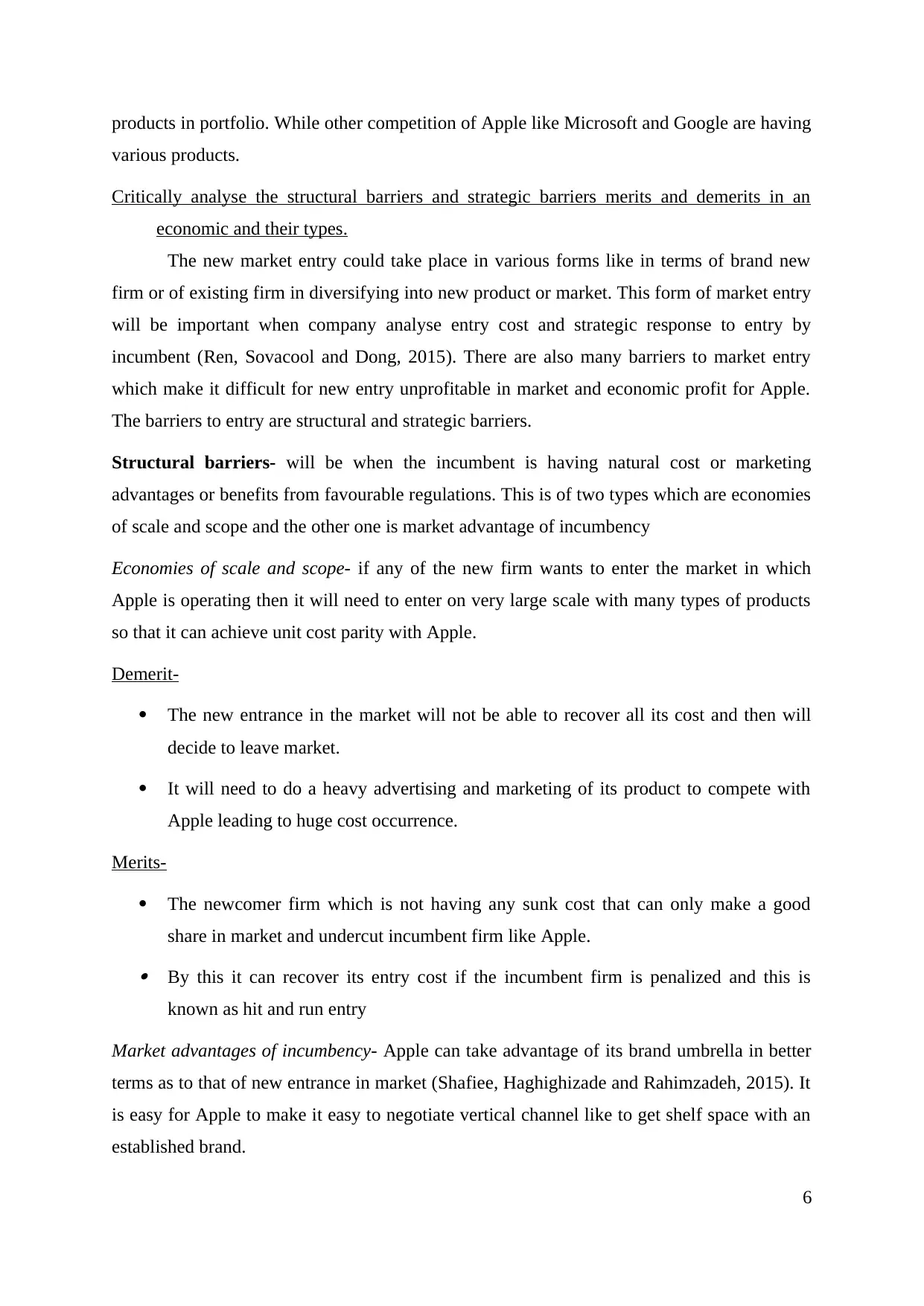
products in portfolio. While other competition of Apple like Microsoft and Google are having
various products.
Critically analyse the structural barriers and strategic barriers merits and demerits in an
economic and their types.
The new market entry could take place in various forms like in terms of brand new
firm or of existing firm in diversifying into new product or market. This form of market entry
will be important when company analyse entry cost and strategic response to entry by
incumbent (Ren, Sovacool and Dong, 2015). There are also many barriers to market entry
which make it difficult for new entry unprofitable in market and economic profit for Apple.
The barriers to entry are structural and strategic barriers.
Structural barriers- will be when the incumbent is having natural cost or marketing
advantages or benefits from favourable regulations. This is of two types which are economies
of scale and scope and the other one is market advantage of incumbency
Economies of scale and scope- if any of the new firm wants to enter the market in which
Apple is operating then it will need to enter on very large scale with many types of products
so that it can achieve unit cost parity with Apple.
Demerit-
The new entrance in the market will not be able to recover all its cost and then will
decide to leave market.
It will need to do a heavy advertising and marketing of its product to compete with
Apple leading to huge cost occurrence.
Merits-
The newcomer firm which is not having any sunk cost that can only make a good
share in market and undercut incumbent firm like Apple. By this it can recover its entry cost if the incumbent firm is penalized and this is
known as hit and run entry
Market advantages of incumbency- Apple can take advantage of its brand umbrella in better
terms as to that of new entrance in market (Shafiee, Haghighizade and Rahimzadeh, 2015). It
is easy for Apple to make it easy to negotiate vertical channel like to get shelf space with an
established brand.
6
various products.
Critically analyse the structural barriers and strategic barriers merits and demerits in an
economic and their types.
The new market entry could take place in various forms like in terms of brand new
firm or of existing firm in diversifying into new product or market. This form of market entry
will be important when company analyse entry cost and strategic response to entry by
incumbent (Ren, Sovacool and Dong, 2015). There are also many barriers to market entry
which make it difficult for new entry unprofitable in market and economic profit for Apple.
The barriers to entry are structural and strategic barriers.
Structural barriers- will be when the incumbent is having natural cost or marketing
advantages or benefits from favourable regulations. This is of two types which are economies
of scale and scope and the other one is market advantage of incumbency
Economies of scale and scope- if any of the new firm wants to enter the market in which
Apple is operating then it will need to enter on very large scale with many types of products
so that it can achieve unit cost parity with Apple.
Demerit-
The new entrance in the market will not be able to recover all its cost and then will
decide to leave market.
It will need to do a heavy advertising and marketing of its product to compete with
Apple leading to huge cost occurrence.
Merits-
The newcomer firm which is not having any sunk cost that can only make a good
share in market and undercut incumbent firm like Apple. By this it can recover its entry cost if the incumbent firm is penalized and this is
known as hit and run entry
Market advantages of incumbency- Apple can take advantage of its brand umbrella in better
terms as to that of new entrance in market (Shafiee, Haghighizade and Rahimzadeh, 2015). It
is easy for Apple to make it easy to negotiate vertical channel like to get shelf space with an
established brand.
6
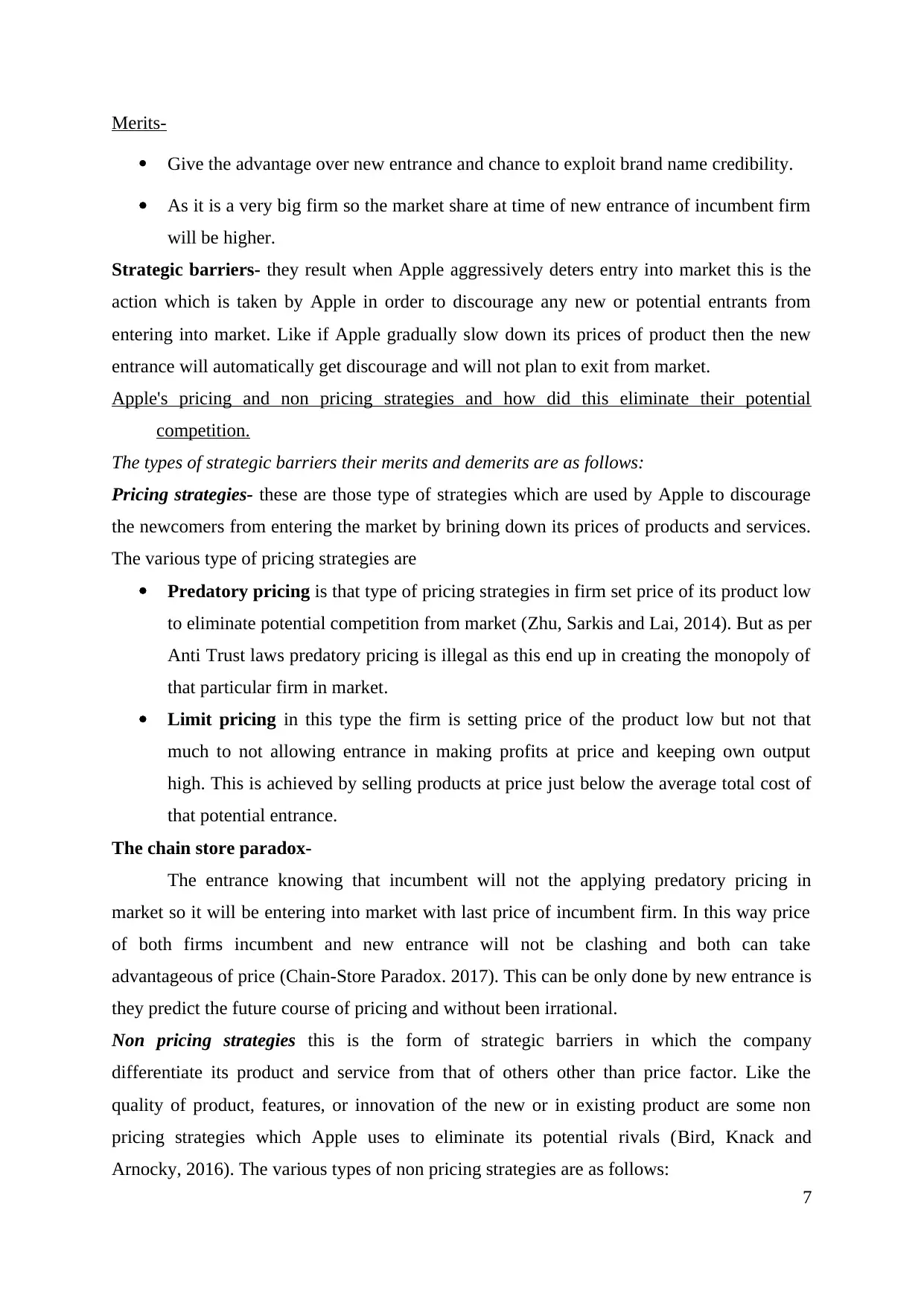
Merits-
Give the advantage over new entrance and chance to exploit brand name credibility.
As it is a very big firm so the market share at time of new entrance of incumbent firm
will be higher.
Strategic barriers- they result when Apple aggressively deters entry into market this is the
action which is taken by Apple in order to discourage any new or potential entrants from
entering into market. Like if Apple gradually slow down its prices of product then the new
entrance will automatically get discourage and will not plan to exit from market.
Apple's pricing and non pricing strategies and how did this eliminate their potential
competition.
The types of strategic barriers their merits and demerits are as follows:
Pricing strategies- these are those type of strategies which are used by Apple to discourage
the newcomers from entering the market by brining down its prices of products and services.
The various type of pricing strategies are
Predatory pricing is that type of pricing strategies in firm set price of its product low
to eliminate potential competition from market (Zhu, Sarkis and Lai, 2014). But as per
Anti Trust laws predatory pricing is illegal as this end up in creating the monopoly of
that particular firm in market.
Limit pricing in this type the firm is setting price of the product low but not that
much to not allowing entrance in making profits at price and keeping own output
high. This is achieved by selling products at price just below the average total cost of
that potential entrance.
The chain store paradox-
The entrance knowing that incumbent will not the applying predatory pricing in
market so it will be entering into market with last price of incumbent firm. In this way price
of both firms incumbent and new entrance will not be clashing and both can take
advantageous of price (Chain-Store Paradox. 2017). This can be only done by new entrance is
they predict the future course of pricing and without been irrational.
Non pricing strategies this is the form of strategic barriers in which the company
differentiate its product and service from that of others other than price factor. Like the
quality of product, features, or innovation of the new or in existing product are some non
pricing strategies which Apple uses to eliminate its potential rivals (Bird, Knack and
Arnocky, 2016). The various types of non pricing strategies are as follows:
7
Give the advantage over new entrance and chance to exploit brand name credibility.
As it is a very big firm so the market share at time of new entrance of incumbent firm
will be higher.
Strategic barriers- they result when Apple aggressively deters entry into market this is the
action which is taken by Apple in order to discourage any new or potential entrants from
entering into market. Like if Apple gradually slow down its prices of product then the new
entrance will automatically get discourage and will not plan to exit from market.
Apple's pricing and non pricing strategies and how did this eliminate their potential
competition.
The types of strategic barriers their merits and demerits are as follows:
Pricing strategies- these are those type of strategies which are used by Apple to discourage
the newcomers from entering the market by brining down its prices of products and services.
The various type of pricing strategies are
Predatory pricing is that type of pricing strategies in firm set price of its product low
to eliminate potential competition from market (Zhu, Sarkis and Lai, 2014). But as per
Anti Trust laws predatory pricing is illegal as this end up in creating the monopoly of
that particular firm in market.
Limit pricing in this type the firm is setting price of the product low but not that
much to not allowing entrance in making profits at price and keeping own output
high. This is achieved by selling products at price just below the average total cost of
that potential entrance.
The chain store paradox-
The entrance knowing that incumbent will not the applying predatory pricing in
market so it will be entering into market with last price of incumbent firm. In this way price
of both firms incumbent and new entrance will not be clashing and both can take
advantageous of price (Chain-Store Paradox. 2017). This can be only done by new entrance is
they predict the future course of pricing and without been irrational.
Non pricing strategies this is the form of strategic barriers in which the company
differentiate its product and service from that of others other than price factor. Like the
quality of product, features, or innovation of the new or in existing product are some non
pricing strategies which Apple uses to eliminate its potential rivals (Bird, Knack and
Arnocky, 2016). The various types of non pricing strategies are as follows:
7
⊘ This is a preview!⊘
Do you want full access?
Subscribe today to unlock all pages.

Trusted by 1+ million students worldwide
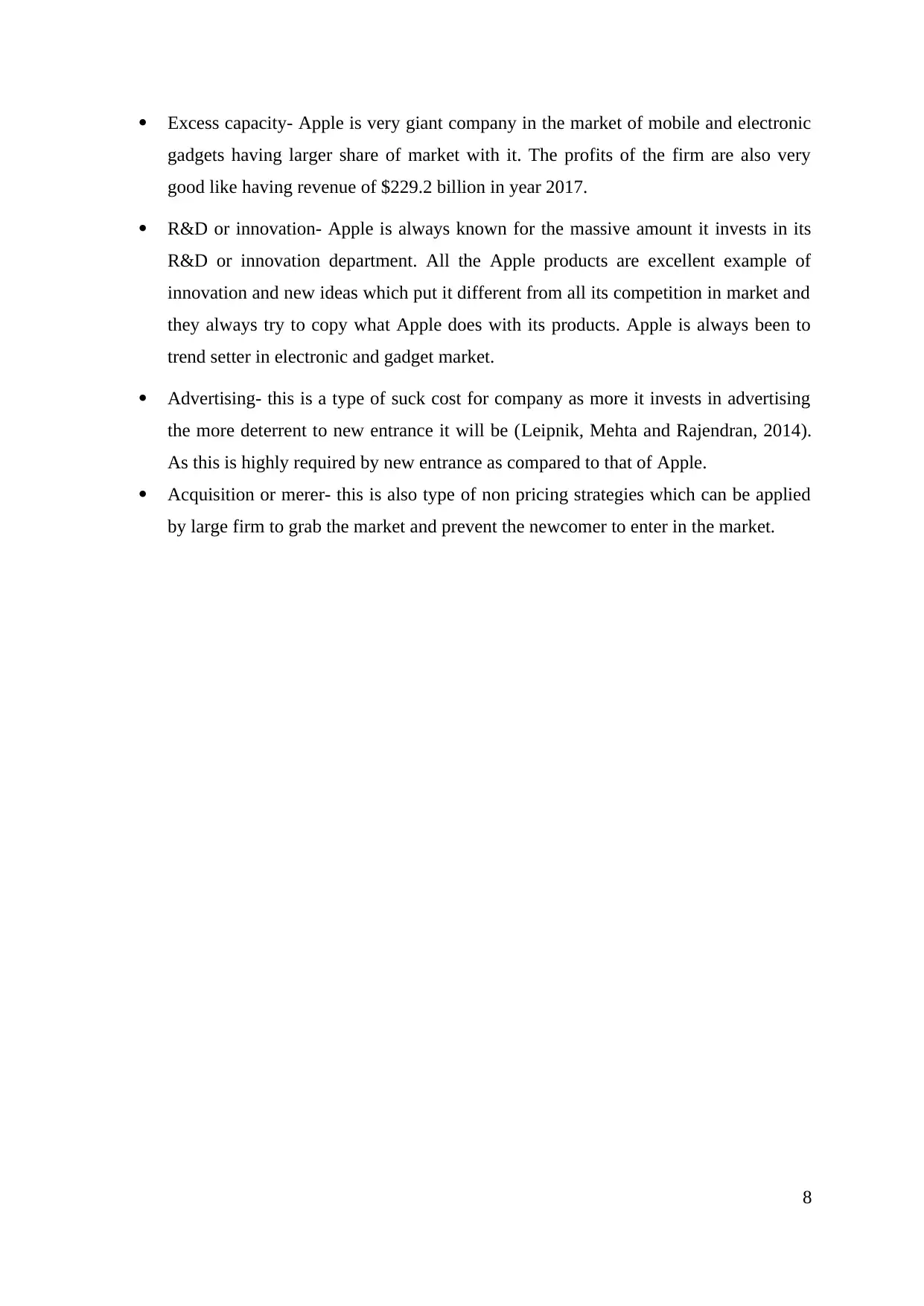
Excess capacity- Apple is very giant company in the market of mobile and electronic
gadgets having larger share of market with it. The profits of the firm are also very
good like having revenue of $229.2 billion in year 2017.
R&D or innovation- Apple is always known for the massive amount it invests in its
R&D or innovation department. All the Apple products are excellent example of
innovation and new ideas which put it different from all its competition in market and
they always try to copy what Apple does with its products. Apple is always been to
trend setter in electronic and gadget market.
Advertising- this is a type of suck cost for company as more it invests in advertising
the more deterrent to new entrance it will be (Leipnik, Mehta and Rajendran, 2014).
As this is highly required by new entrance as compared to that of Apple.
Acquisition or merer- this is also type of non pricing strategies which can be applied
by large firm to grab the market and prevent the newcomer to enter in the market.
8
gadgets having larger share of market with it. The profits of the firm are also very
good like having revenue of $229.2 billion in year 2017.
R&D or innovation- Apple is always known for the massive amount it invests in its
R&D or innovation department. All the Apple products are excellent example of
innovation and new ideas which put it different from all its competition in market and
they always try to copy what Apple does with its products. Apple is always been to
trend setter in electronic and gadget market.
Advertising- this is a type of suck cost for company as more it invests in advertising
the more deterrent to new entrance it will be (Leipnik, Mehta and Rajendran, 2014).
As this is highly required by new entrance as compared to that of Apple.
Acquisition or merer- this is also type of non pricing strategies which can be applied
by large firm to grab the market and prevent the newcomer to enter in the market.
8
Paraphrase This Document
Need a fresh take? Get an instant paraphrase of this document with our AI Paraphraser
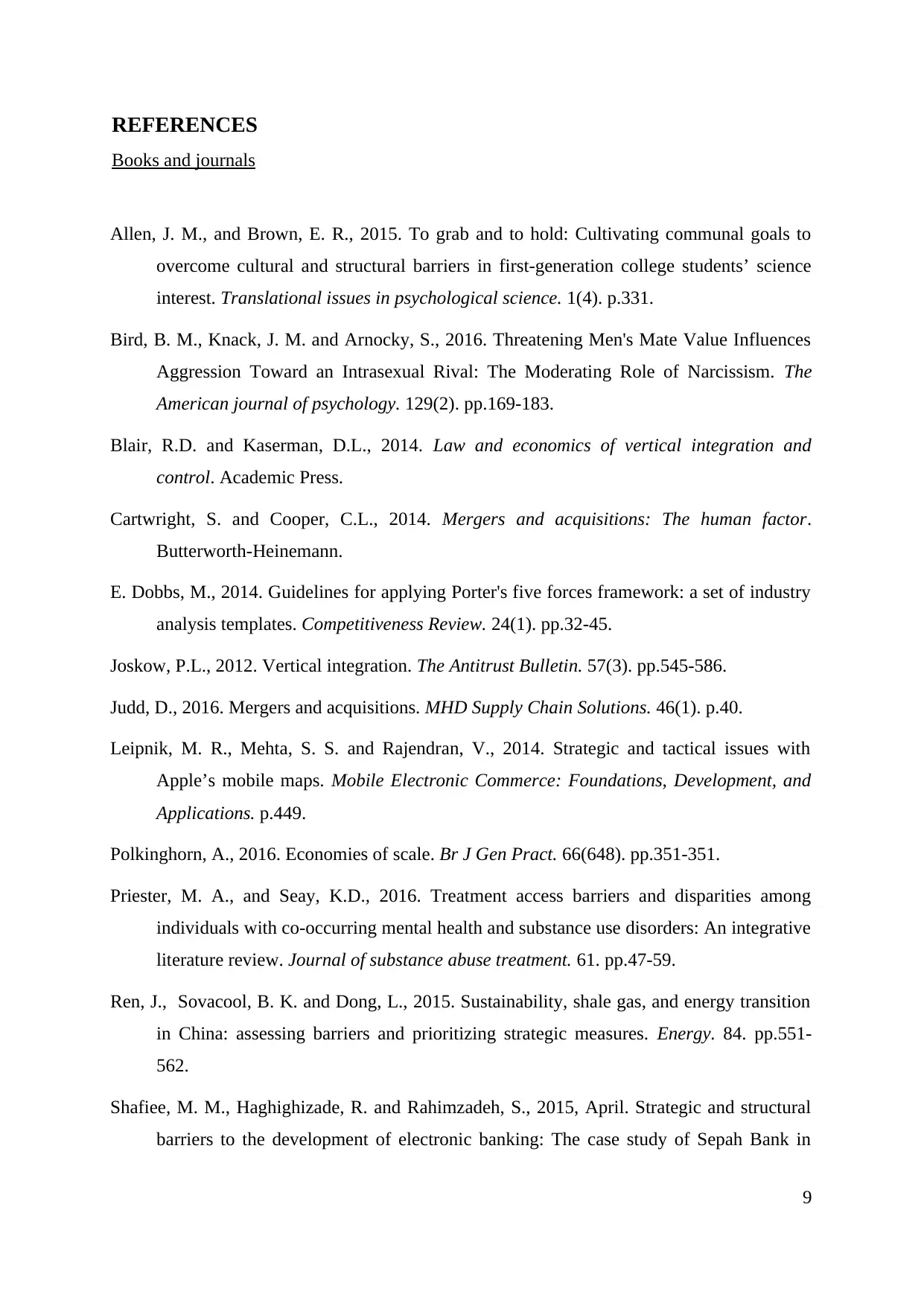
REFERENCES
Books and journals
Allen, J. M., and Brown, E. R., 2015. To grab and to hold: Cultivating communal goals to
overcome cultural and structural barriers in first-generation college students’ science
interest. Translational issues in psychological science. 1(4). p.331.
Bird, B. M., Knack, J. M. and Arnocky, S., 2016. Threatening Men's Mate Value Influences
Aggression Toward an Intrasexual Rival: The Moderating Role of Narcissism. The
American journal of psychology. 129(2). pp.169-183.
Blair, R.D. and Kaserman, D.L., 2014. Law and economics of vertical integration and
control. Academic Press.
Cartwright, S. and Cooper, C.L., 2014. Mergers and acquisitions: The human factor.
Butterworth-Heinemann.
E. Dobbs, M., 2014. Guidelines for applying Porter's five forces framework: a set of industry
analysis templates. Competitiveness Review. 24(1). pp.32-45.
Joskow, P.L., 2012. Vertical integration. The Antitrust Bulletin. 57(3). pp.545-586.
Judd, D., 2016. Mergers and acquisitions. MHD Supply Chain Solutions. 46(1). p.40.
Leipnik, M. R., Mehta, S. S. and Rajendran, V., 2014. Strategic and tactical issues with
Apple’s mobile maps. Mobile Electronic Commerce: Foundations, Development, and
Applications. p.449.
Polkinghorn, A., 2016. Economies of scale. Br J Gen Pract. 66(648). pp.351-351.
Priester, M. A., and Seay, K.D., 2016. Treatment access barriers and disparities among
individuals with co-occurring mental health and substance use disorders: An integrative
literature review. Journal of substance abuse treatment. 61. pp.47-59.
Ren, J., Sovacool, B. K. and Dong, L., 2015. Sustainability, shale gas, and energy transition
in China: assessing barriers and prioritizing strategic measures. Energy. 84. pp.551-
562.
Shafiee, M. M., Haghighizade, R. and Rahimzadeh, S., 2015, April. Strategic and structural
barriers to the development of electronic banking: The case study of Sepah Bank in
9
Books and journals
Allen, J. M., and Brown, E. R., 2015. To grab and to hold: Cultivating communal goals to
overcome cultural and structural barriers in first-generation college students’ science
interest. Translational issues in psychological science. 1(4). p.331.
Bird, B. M., Knack, J. M. and Arnocky, S., 2016. Threatening Men's Mate Value Influences
Aggression Toward an Intrasexual Rival: The Moderating Role of Narcissism. The
American journal of psychology. 129(2). pp.169-183.
Blair, R.D. and Kaserman, D.L., 2014. Law and economics of vertical integration and
control. Academic Press.
Cartwright, S. and Cooper, C.L., 2014. Mergers and acquisitions: The human factor.
Butterworth-Heinemann.
E. Dobbs, M., 2014. Guidelines for applying Porter's five forces framework: a set of industry
analysis templates. Competitiveness Review. 24(1). pp.32-45.
Joskow, P.L., 2012. Vertical integration. The Antitrust Bulletin. 57(3). pp.545-586.
Judd, D., 2016. Mergers and acquisitions. MHD Supply Chain Solutions. 46(1). p.40.
Leipnik, M. R., Mehta, S. S. and Rajendran, V., 2014. Strategic and tactical issues with
Apple’s mobile maps. Mobile Electronic Commerce: Foundations, Development, and
Applications. p.449.
Polkinghorn, A., 2016. Economies of scale. Br J Gen Pract. 66(648). pp.351-351.
Priester, M. A., and Seay, K.D., 2016. Treatment access barriers and disparities among
individuals with co-occurring mental health and substance use disorders: An integrative
literature review. Journal of substance abuse treatment. 61. pp.47-59.
Ren, J., Sovacool, B. K. and Dong, L., 2015. Sustainability, shale gas, and energy transition
in China: assessing barriers and prioritizing strategic measures. Energy. 84. pp.551-
562.
Shafiee, M. M., Haghighizade, R. and Rahimzadeh, S., 2015, April. Strategic and structural
barriers to the development of electronic banking: The case study of Sepah Bank in
9
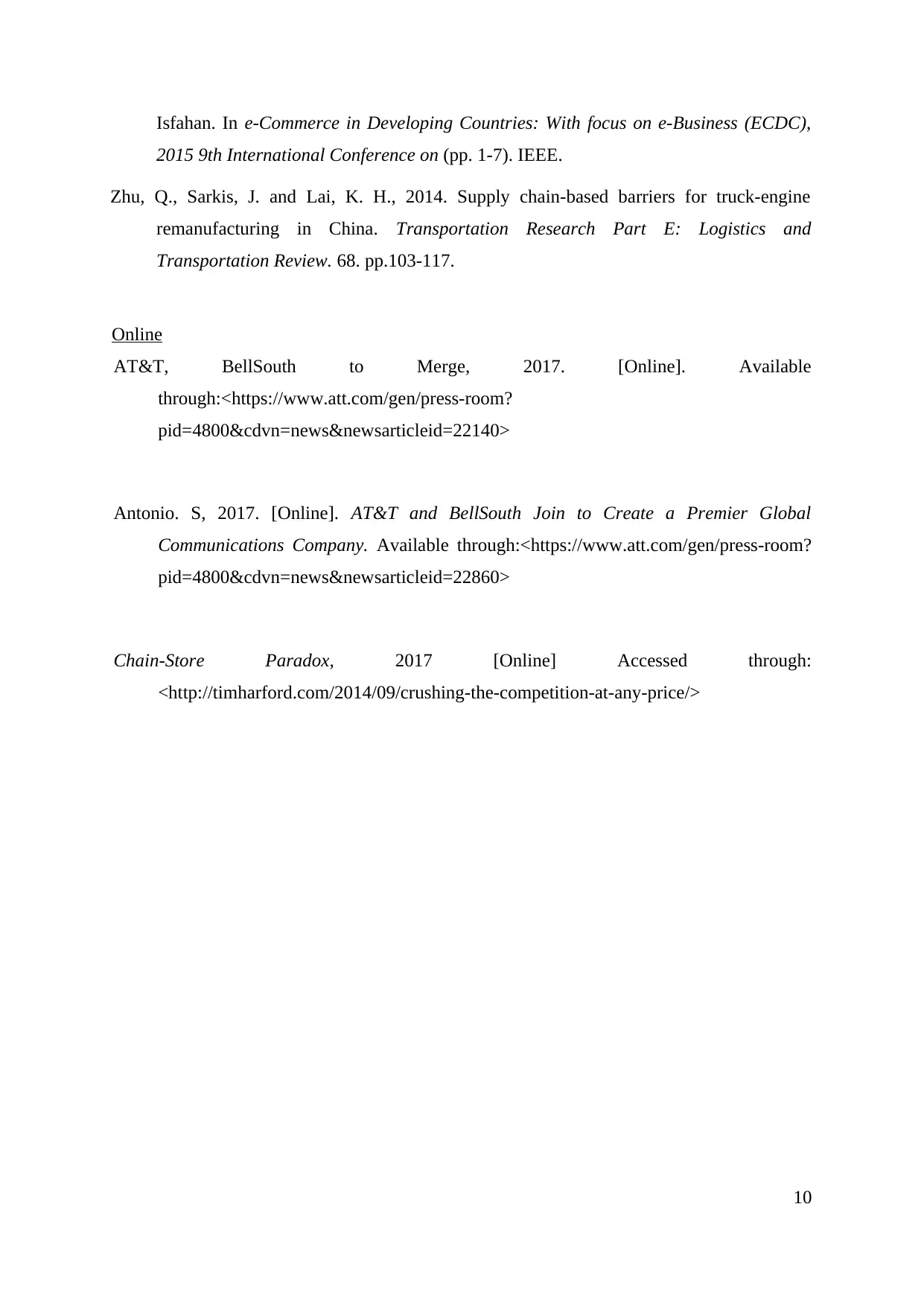
Isfahan. In e-Commerce in Developing Countries: With focus on e-Business (ECDC),
2015 9th International Conference on (pp. 1-7). IEEE.
Zhu, Q., Sarkis, J. and Lai, K. H., 2014. Supply chain-based barriers for truck-engine
remanufacturing in China. Transportation Research Part E: Logistics and
Transportation Review. 68. pp.103-117.
Online
AT&T, BellSouth to Merge, 2017. [Online]. Available
through:<https://www.att.com/gen/press-room?
pid=4800&cdvn=news&newsarticleid=22140>
Antonio. S, 2017. [Online]. AT&T and BellSouth Join to Create a Premier Global
Communications Company. Available through:<https://www.att.com/gen/press-room?
pid=4800&cdvn=news&newsarticleid=22860>
Chain-Store Paradox, 2017 [Online] Accessed through:
<http://timharford.com/2014/09/crushing-the-competition-at-any-price/>
10
2015 9th International Conference on (pp. 1-7). IEEE.
Zhu, Q., Sarkis, J. and Lai, K. H., 2014. Supply chain-based barriers for truck-engine
remanufacturing in China. Transportation Research Part E: Logistics and
Transportation Review. 68. pp.103-117.
Online
AT&T, BellSouth to Merge, 2017. [Online]. Available
through:<https://www.att.com/gen/press-room?
pid=4800&cdvn=news&newsarticleid=22140>
Antonio. S, 2017. [Online]. AT&T and BellSouth Join to Create a Premier Global
Communications Company. Available through:<https://www.att.com/gen/press-room?
pid=4800&cdvn=news&newsarticleid=22860>
Chain-Store Paradox, 2017 [Online] Accessed through:
<http://timharford.com/2014/09/crushing-the-competition-at-any-price/>
10
⊘ This is a preview!⊘
Do you want full access?
Subscribe today to unlock all pages.

Trusted by 1+ million students worldwide
1 out of 13
Your All-in-One AI-Powered Toolkit for Academic Success.
+13062052269
info@desklib.com
Available 24*7 on WhatsApp / Email
![[object Object]](/_next/static/media/star-bottom.7253800d.svg)
Unlock your academic potential
Copyright © 2020–2025 A2Z Services. All Rights Reserved. Developed and managed by ZUCOL.